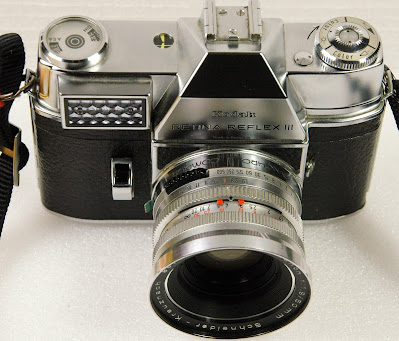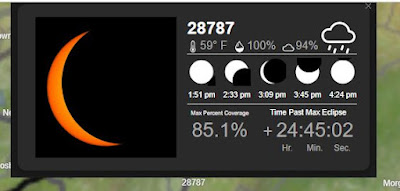 |
| Kodak's first Retina Reflex (Type 025) October 1958 ad in Popular Photography |
Over the years, I’ve tried out a number of 1950s - 60s SLRs with leaf shutters, such as the Zeiss-Ikon Contaflex, the Topcon Uni, Kowa SET series, and of course, the Kodak Retina Reflex. Leaf shutters in SLRs are limited by two main attributes - the typical maximum 1/500 sec shutter speed, and the small throat diameter of the lens where it attaches to the body. That limits the maximum aperture as well as lenses wider than 28mm. In addition, many cameras have a lens behind the shutter, with the front elements having to use that rear lens as part of the focus mechanism. In other words, if the lens was removable, only the front section could be removed, and those optics depended on the rear (behind the shutter) elements to complete the optics. That’s how it was with the Contaflex and the first iteration of the Retina Reflex (Type 025). Most of the Kodak Retina rangefinder cameras worked the same way if the front elements were removable. It was probably a response to the appearance of the Contaflex in 1956, that Kodak AG was able to quickly come out with an SLR, albeit one that has the distinct lineage of the Retina C-series rangefinder lenses.
 |
| Kodak Retina Reflex (Type 025) with its lens system a derivative from the IIC and IIIC Retina rangefinders |
My earliest opportunities to use a Kodak Retina SLR were disappointing. That earliest model is now as old as I am, as they came out in 1956. Most of the ones I have handled either had problems with the mirror coating de-silvering, fungus on lens elements, or some other mechanical problem. So, I never seriously considered using one until I recently got a Retina Reflex S and Reflex III. That experience has improved my view of the lens-shutter SLR, with some caveats to follow.
When lens-shutter SLRs first appeared in the 1950s, none of them had an instant return mirror. In fact, no 35mm SLR had an auto-return mirror until the Asahiflex II appeared in 1954. None of the Retina Reflex series camera have an instant-return mirror. You must wind the film for the next shot to release the mirror. That’s one thing that certainly improved since the 1950s!
For the rest of this, I’m only going to discuss the later Retina Reflex SLRs with the DKL lens system - that is, each lens has all the optics in the removable lens, with no lenses behind the shutter. I’ll discuss the DKL lenses a bit farther on.
The Retina Reflex S, III, and IV, as well as the Instamatic Reflex use the same lenses, which range from 28mm to 200mm focal lengths. It was standard for the cheapest kit to come with a 50mm f/2.8 Retina Xenar (a Schneider lens). A faster 50mm f/1.9 Retina Xenon was the pricier version. The other focal lengths are 28mm f/4, 35mm f/2.8, 85mm f/4, 135mm f/4, and 200mm f/4.8. These are all well-made Schneider lenses.
So of course, there is also a multitude of accessories, making the Retina Reflex a complete system, and now, also a rabbit hole for the collector/enthusiast of these cameras. But first, some looks at the Reflex S and Reflex III cameras.
 |
| Retina Reflex S (Type 034) |
The Retina Reflex S, produced from 1959-1960, was the first model to use the DKL lens mount, and also has a coupled Selenium exposure meter. The top-mounted shutter release, film release and door release are the same as the original Retina Reflex.
 |
| Retina Reflex III (Type 041) |
The Retina Reflex III is not too different from the S model, and was produced from 1960-64. The main differences are the placement of the shutter release on the front of the body, the metering needle visible in the viewfinder, and the film counter reset button on the base of the camera.
 |
| Retina Reflex IV (Type 051) |
The Retina Reflex IV, manufactured from 1964-1967, was the last 35mm SLR made by Kodak A.G. It’s quite similar to the model III, but has a small window to view the aperture/shutter speed settings in the viewfinder. The PC flash connector also moved from the front of the camera to the edge of the left side of the lens mount. The camera also features a normal flash hot-shoe on top of the prism.
 |
| Instamatic Reflex (Type 062) |
The Kodak Instamatic Reflex was manufactured from 1968 to 1974, and features a CdS exposure meter, and a Compur Electronic shutter that goes from 20 sec to 1/500. It uses the Kodak Kodapak 126 cartridge to produce 28mm x28mm images. Typically, it came with a Retina Xenar 45mm f/2.8 lens. It’s able to use any of the lenses that fit the Reflex S through IV models.
LENSES
The DKL lens mount, which is used on the Retina Reflex S- IV and Instamatic Reflex, as well as the rangefinder Retina IIIS, is also used on several other brands. Developed by F. Deckel in Munich, the lens mount, which features a Synchro-Compur leaf shutter, was introduced in 1956. Used by Voigtlander, Braun, Edixa, Iloca, Balda, and Kodak, each brand has a distinct keying of the lens to the mount, so the lenses are not interchangeable among brands. For the Retina Reflex S series, there were a number of lenses available:
Rodenstock: Eurygon 30mm/2.8 and 35mm/4, Heligon 50mm/1.9, Ysarex 50mm/2.8, Rotelar R 85mm/4 and 135mm/4 (Rodenstock lenses are more likely to be seen on Retina Reflex cameras in Europe)
Schneider: Curtagon 28mm/4 and 35mm/2.8, Xenon 50mm/1.9, Xenar 45mm/2.8, Xenar 50mm/2.8, Tele-Arton 85mm/4, Tele-Xenar 135mm/4 and 200mm/4.8 and
Steinheil: Culminar 50mm/2.8.
 |
| Retina Reflex S with 200mm Tele-Xenar |
The Retina Reflexes, all made by Kodak A.G in Stuttgart, Germany are well-made, precision cameras. It’s interesting to note that after Eastman Kodak acquired the Nagel-Werke company in 1931, August Nagel designed the Daylight Loading Cartridge (35mm) for the Retina camera, which became the standard cassette design used thereafter by all the manufacturers. So, while Leica may have started the 35mm “miniature” camera, it was the standard Daylight Loading Cartridge that really made 35mm into being the predominant format in years to come.
 |
| Samigon 2x teleconverter for the DKL mount |
What about using Retina Reflex cameras today?
While these cameras are getting rather old, many of them continue to work well, though the meters may not be dependable. Problems that I have seen are usually that the mirrors suffer oxidation or corrosion, with the viewfinders becoming dim, or with tiny black spots in the field of view. That doesn’t affect the images, but it does affect the usability. I would definitely steer away from the original Retina Reflex (Type 025), as the lens selection is basically very limited and the viewfinder somewhat dimmer due to the smaller maximum aperture of the lenses. However, the Reflex S, III, and IV all are capable of excellent images, and take the full range of lenses from 28-200mm.
While Kodak used the EV system on their Retina series of cameras, such that once you choose an EV, all the shutter speeds and apertures are linked to that chosen EV. This is actually the same as using the Hasselblad and some other cameras where you have that option. It can be quite useful or infuriating, depending on your knowledge of the camera and the light. However, on the Reflex S and later, you can set your shutter speed and then adjust the aperture using the little wheel underneath the base of the lens. For that reason, I find the Retina Reflex S to be quite easy to use. On the Retina Reflex III or IV, you have a view of the meter’s operation within the viewfinder, which is quite handy -- if the meter is accurate! Otherwise, the Reflex S is as good a choice, especially since the shutter release is on the top deck where I usually expect it to be on a camera.
 |
| the little wheel at the base of the lens mount controls the aperture |
If you do purchase any Retina camera, reflex or rangefinder, you’ll find that there are little quirks that need to be addressed, such as resetting the frame counter to be able to cock the shutter. If your camera didn’t come with a manual, it’s to your advantage to go to the camera manuals site and download a copy of the manual - and pay Mike Butkus a small fee.
There are some nice aspects to the Retina Reflex cameras - since they have a lens shutter, they are quiet, in comparison to a focal plane shutter SLR. The cameras are fairly simple to use, and if working properly, will give you excellent results. If you are looking to have a good kit, I recommend the 28mm f/4 Retina Curtagon, the 35mm f/2.8 Retina Xenar, the 50mm f/1.9 Retina Xenon, and the 80mm f/4 Rodennstock Retina-Heligon C. One aspect of the long-focus lenses from 80mm and on, is that the close-focus distance is much farther than comparable focal lengths on focal-plane shutter SLRs. There is no “macro” lens for the Retina Reflex series, but you can find close-up diopters that fit in front of the 50mm f/2.8 and 50mm f/1.9. There’s also an extension tube that gives you macro capability, and there is a third-party 2x teleconverter made for the DKL lenses. You can also find a right-angle viewfinder if you need to use one.
 |
| Right-angle finder for the Retina Reflex |
As far as I know, there are no repair shops that will undertake work on Retina Reflex cameras. So, if your camera is working fine, take good care of it. If it’s not working as it should, find another one that does work. That being said, I recommend the Retina Reflex S series over the Contaflex models and Voigtlander Bessamatic. There are many more lens options and prices are understandably less for the Schnieder lenses than those from Voigtlander and Zeiss-Ikon.
 |
| Two close-up lenses that fit 60mm threads |
I highly recommend “Collecting and Using Classic SLRs” by Ivor Matanle (Thames and Hudson, 1997), and “The Retina Reflex Way” by L.A, Mannheim (Focal Press, 1965). There are also several web sites with very useful information and reviews, as follows:
- https://all-my-cameras.com/2017/12/21/the-kodak-retina-reflex-iv/
- https://retinarescue.com/
- https://blog.jimgrey.net/2020/05/20/kodak-retina-reflex-iii/
- http://camera-wiki.org/wiki/Retina_Reflex
To sum it all up - The Kodak Retina Reflex S and subsequent models are robust, well-made examples of lens-shutter SLRs. If you have one in working condition, it makes sense to acquire additional lenses in different focal lengths, just as with typical focal-plane SLRs. They are quiet, capable of excellent photos, and good-looking classical cameras that deserve a try. No batteries needed!
Some photo examples from the Reflex S, 50mm f/1.9 Xenon lens, Kentmere 100 film
Examples from Reflex III with Fuji Superia 200 film, various lenses.























































